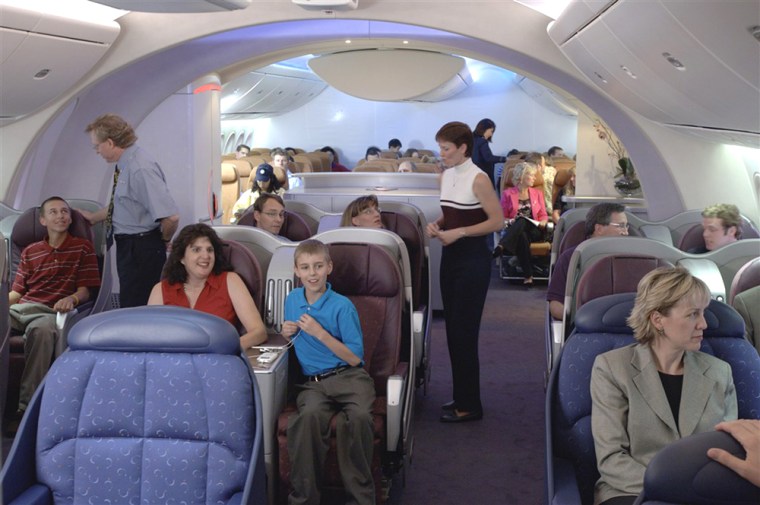Boeing postponed the first flight of its new 787 Dreamliner, pushing the test to the end of September from the end of August, and has boosted research-and-development funds to ensure the fuel-efficient jetliner will overcome last-minute snarls and still enter service on time.
The slight delay remains within the window management has said would be consistent with the first 787 delivery to All Nippon Airways in May 2008.
"We are spending more than originally planned to ensure we make our commitments," Boeing Chairman and Chief Executive James McNerney told analysts and media on a July 25 earnings call. "We are facing some challenges."
The announcement did little to dampen a very strong second quarter. Continued robust commercial airplane sales, improved productivity, and steady financial performance from the company's defense division contributed to its largest profit in nearly four years. The Chicago aerospace giant said it earned $1.1 billion, or $1.35 a share, in the second quarter on revenue of $17 billion — up 14 percent. That's compared with a loss of $160 million, or 21¢ a share last year, when the company paid a $615 million government fine.
The better-than-expected results, the best since the fourth quarter of 2003, surpassed Wall Street's expectations. Shares of Boeing rose 3.3 percent, to $107.83 — a new 52-week high — July 25 on the New York Stock Exchange, before settling at $107.23. Over the past year, the stock has increased 28 percent. Heidi Wood, an aerospace analyst for Morgan Stanley (MS), calls the quarterly performance "very nice. It was an uncharacteristically clean quarter without charges and favorable one-time items."
Boeing raised its 2007 profit forecast to $4.80 to $4.95 per share, from $4.55 to $4.75. It projected sales of $65 billion, up from a previous forecast of about $64.5 billion. Analysts predict per-share earnings of $4.90 for the year on sales of about $65.2 billion. The company maintained its 2008 earnings forecast at $5.55 to $5.75 a share. The company also raised its 2007 operating cash flow by $2 billion, to more than $6 billion, largely reflecting the strength of new order deposits.
The company reiterated its forecast for a 12 percent boost in commercial airplane deliveries this year to 445 aircraft, which reflects two consecutive years of record airplane orders. It forecasts deliveries of 515 to 520 aircraft next year. Sales from the company's commercial airplane division grew 22 percent, to $8.7 billion on higher deliveries. The unit's profit jumped 34 percent, to $960 million, for a operating profit margin of 11 percent. The order backlog is now valued at $208 billion.
For Boeing, about the only potential glitch in a near flawless quarter is the increasing pressure to meet its ambitious 787 delivery schedule. Boeing raised its R&D expenses to $3.7 billion for the year — up from $3.2 billion — as it races the clock to ready the aircraft for its first flight to ensure production doesn't fall behind. "It's the scramble at the end of the program," McNerney said. "Increasing R&D is the right thing to do to keep our successful airplane programs on track."
McNerney said the 787's troubles fall into three categories. The biggest delay for first flight is centered on integrating the various software systems with the hardware, which is a typical challenge for a new airplane program. Still, McNerney said the company has "no reason to believe we'll face a major issue there." Engineers are still testing flight-critical software, the fuselage, and the craft's wings.
The other two areas of concern continue to be supporting major suppliers and trying to reduce overall weight of the aircraft. Some of the first-tier suppliers still are struggling to iron out the kinks of a new composite-based manufacturing system. Key questions revolve around replicating the fuselage sections at higher production rates that produce consistent quality and ramping up to meet the surge in demand for the Dreamliner. For its part, Boeing continues to send teams around the globe to help suppliers stay on track and share best practices.
The aircraft remains about 2 percent heavier than it should be, Boeing executives say. Engineers have been scrambling to redesign parts of the wing and window frames to meet its weight targets, but it's unclear whether Boeing will meet them by the time it assembles the first production jet for ANA. "Our projection is a small weight gain, a percent or two," McNerney said. But he said even a slightly heavier aircraft would still meet its performance obligations to airlines. "Most of our commitment to customers is along operating cost guarantees, and we're well above those guarantees," McNerney said. "We can absorb a little bit."
